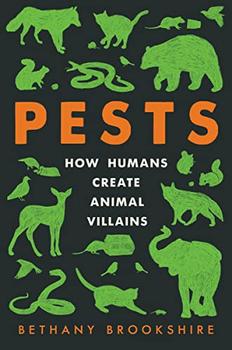Summary | Excerpt | Reviews | Beyond the Book | Readalikes | Genres & Themes | Author Bio

How Humans Create Animal Villains
by Bethany Brookshire
Nyhus has been able to pin it down a little. He has categorized human-wildlife conflict into eight quadrants on a graph. On the horizontal axis is how positive or negative an encounter with an animal (for the purposes of this book) or plant is. On the vertical axis is how intense that interaction could be. On the third axis—extending forward out of the page—is how frequent an encounter with a species is. He can then put animal encounters into the eight three-dimensional potential cubes of human judgment. For me, for example, snuggling a wombat on a trip to Australia would end up in the cube at the top back right. It's rare, very positive, has a high emotional impact, and is on my bucket list. On the bottom right toward the front, you might have common but only slightly positive encounters, such as seeing a robin in a nearby tree (or a peacock in a zoo). It's nice, but it's not unusual, and it probably doesn't deeply affect someone's life. In the cube at the back top left are the meetings that are rare, negative, and can end badly, such as physical encounters with sharks (very, very rare), grizzly bears, or tigers. They are extremely uncommon (most of the time, sharks swim right by, bears go the other way, and there's no direct encounter), but the odds of personal injury or even death from conflict are high.
The front bottom-left cube, though, is where it gets interesting. This is where people and animals meet in ways that are common and negative, but that have a minor impact. Not life threatening (usually), but irritating. Stepping in goose poop. Rats in the basement. Mice in the barn. "On average it's those negative common species that would include the agricultural animals and would include those things in your garden," Nyhus says.
The animals on the left side of Nyhus's graph are in for a rough time. We often respond to negative interactions with nature by killing the offender. People call the interactions we have with these animals "human-wildlife conflict," and we are happy to start the fight. We'll fence them out, fence them in, relocate them, and if all else fails, bring out the gun and the poison.
Sometimes it's not just out of irritation. Some of the objects of our wars are apex predators, like the lions, tigers, and wolves that haunt the back upper left of the graph and populate our cautionary fairy tales.
Pests are a step or two below these wilderness Disney villains. Most of the time, pests don't consider humans a potential snack. If a pest does cause death or injury, it's often by chance. If a deer and a car collide, a coyote eats a cat, or mouse poop spreads disease, the animals were not out to harm people.
These generally irritating critters don't tend to cause us the intense fear and anxiety that lions, grizzly bears, or sharks do. They don't directly harm us most of the time. They harm our stuff—snacking on our pets, nesting in our car engines, and pooping on our statuary.
We view their depredations with annoyance. Humans have spent so much of our history trying to keep the weather and the world out of hearth and home that when nature outeats, outbreeds, and outsmarts our best efforts, it's no wonder we end up so angry.
Pests are a problem as old as ownership.
When people were fully immersed in the natural world, had no houses, and grew no crops, the word "pest" probably didn't have a lot of meaning. Other animals were competition, or threats. Birds pecked at the sweet berries we craved. Predators with bigger teeth might have driven us away from that tasty carcass we were about to scavenge. We were part of the natural world, and that included the rivalry for resources.
For a pest to be a pest, people have to have a sense of ownership over stuff they want to protect, and they need to see the difference between what is theirs and what isn't.
Luckily for the pests of the world, people have been hoarding stuff for a very, very long time. We've had storehouses full of grain, haunches of meat, and baskets of fruit. We've left behind food scraps, poop, animal fur, and hair other animals could eat or use. Sure, one creature's trash is another's treasure. But animals helping themselves to our carefully hoarded food? You mess with our food, you mess with us.
Excerpted from Pests by Bethany Brookshire. Copyright © 2022 by Bethany Brookshire. Excerpted by permission of Ecco. All rights reserved. No part of this excerpt may be reproduced or reprinted without permission in writing from the publisher.
Your guide toexceptional books
BookBrowse seeks out and recommends the best in contemporary fiction and nonfiction—books that not only engage and entertain but also deepen our understanding of ourselves and the world around us.